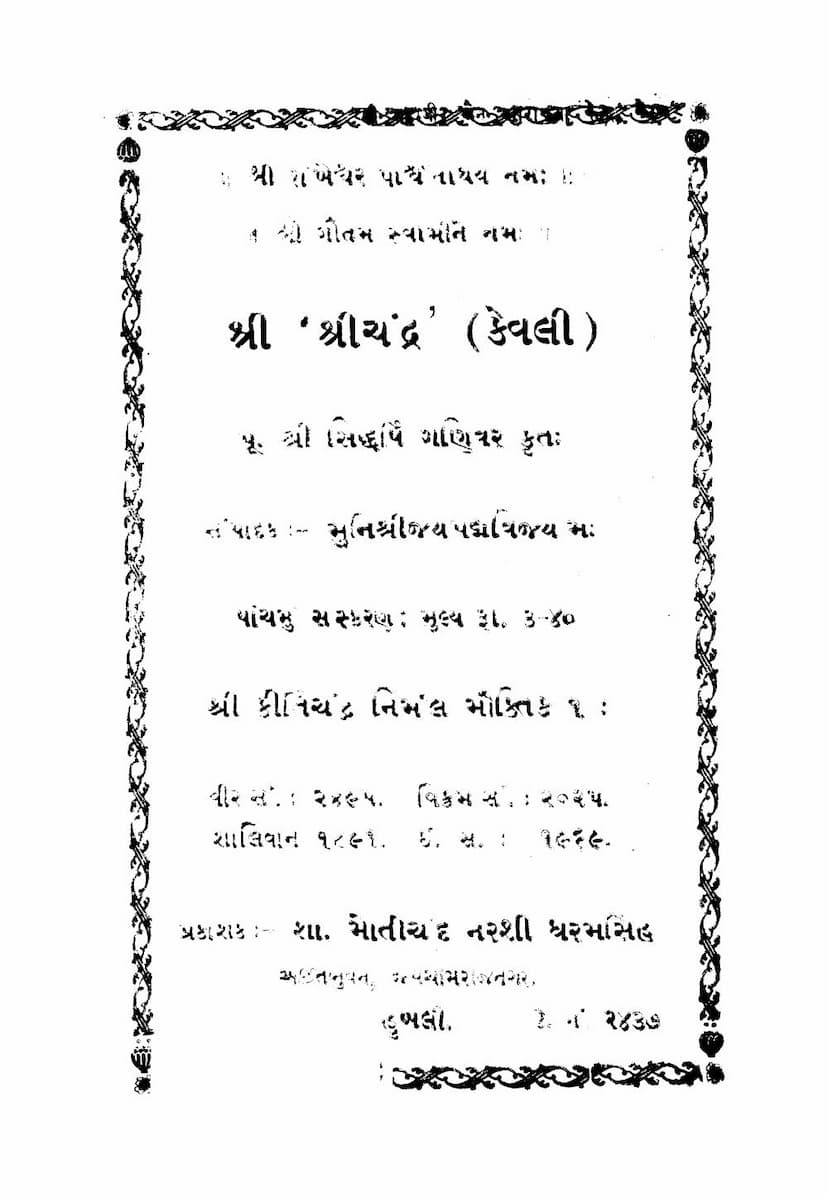Shreechandra Kevali
Added to library: September 2, 2025

Summary
Here's a comprehensive summary of the Jain text "Shreechandra Kevali" based on the provided pages:
Book Title: Shreechandra Kevali (Shreechandra the Omniscient) Author: Siddharshi Gani Editor/Translator: Muni Shri Jaypadmavijayji Publisher: Shah Motichand Narsinh Dharmasinh Theme: The life and teachings of Shreechandra Kevali, a prominent figure in Jainism, emphasizing spiritual discipline, virtuous conduct, and the path to liberation. The narrative is rich with moral lessons and philosophical insights rooted in Jain principles.
Key Aspects of the Text:
-
Invocations and Acknowledgements:
- The book begins with respectful salutations to prominent Jain figures like Gautam Swami and Shree Shankheshwar Parshvanath.
- It acknowledges the original Sanskrit work by Siddharshi Gani and the translation/editing by Muni Shri Jaypadmavijayji.
- The text expresses gratitude to donors and supporters, indicating a community effort in publishing the work.
-
Emphasis on Jain Principles:
- Ahimsa (Non-violence): The core principle of Jainism is evident throughout, advocating for the protection of all living beings.
- Tapasya (Austerities): The text highlights the significance of various austerities, particularly the Vardhaman Ayambil Tap, which involves rigorous fasting and discipline. The numerous individuals mentioned for completing these difficult rituals underscore their importance.
- Dharma (Righteousness): The narrative consistently guides readers towards righteous conduct, emphasizing the importance of faith, detachment, and spiritual knowledge.
- Karma: The concept of karma and its role in shaping one's destiny is a recurring theme, stressing that actions have consequences.
- Moksha (Liberation): The ultimate goal of the Jain path is liberation from the cycle of birth and death, achieved through diligent practice of the prescribed principles.
-
Narrative Style and Content:
- Illustrative Stories: The text uses captivating stories and anecdotes to illustrate Jain teachings. The life of Shreechandra Kevali is presented as a central narrative, interspersed with other exemplary lives and teachings.
- Moral and Ethical Lessons: Each story serves as a vehicle for conveying moral and ethical lessons, promoting virtues like truthfulness, humility, compassion, and perseverance.
- Philosophical Depth: The text delves into Jain philosophy, explaining concepts like the soul's journey through different life forms (8.4 million species), the illusion of worldly pleasures, and the path to true happiness.
- The Importance of Self-Effort: It emphasizes that while enlightened beings (like Tirthankaras) guide the path to liberation, each individual must strive through their own efforts to overcome karma and achieve moksha.
- The Power of the Navkar Mantra: The text frequently mentions the efficacy of the Navkar mantra and other sacred chants in overcoming obstacles and seeking divine protection.
-
Detailed Accounts and Examples:
- Vardhaman Ayambil Tap: The text dedicates significant space to individuals who have undertaken this rigorous fast, listing many names and the extent of their austerities (e.g., number of Ayambil meals, fasting periods). This highlights the dedication required for spiritual progress.
- Shreechandra's Virtues: Shreechandra is portrayed as a figure of immense virtue, demonstrating extraordinary knowledge, spiritual attainment, and unwavering devotion. His life serves as an ideal example.
- Supernatural Occurrences and Miracles: The text includes accounts of miraculous events and divine interventions, often associated with the power of spiritual practices, devotion, and the grace of Jain deities.
- Socio-Cultural Context: The narratives provide glimpses into societal norms, customs, and beliefs prevalent during the time the stories are set, often contrasting them with Jain ideals. For instance, the critique of materialistic pursuits and societal hypocrisy is evident.
-
Structure and Organization:
- The book is divided into chapters, each focusing on a specific aspect of the narrative or a particular teaching. The initial chapters lay the foundation, introducing the core tenets, while subsequent chapters delve into specific stories and philosophical explanations.
- The inclusion of detailed lists of individuals who performed specific austerities suggests an effort to inspire and provide a record of devotional achievements.
In Essence:
"Shreechandra Kevali" is a profound Jain text that aims to guide readers towards a spiritually fulfilling life. It uses the exemplary life of Shreechandra and the practices of numerous devotees to illustrate the path to liberation. The book stresses the importance of virtuous actions, rigorous self-discipline (especially through austerities like Ayambil), unwavering faith in Jain principles, and the power of devotion and righteousness in overcoming the cycles of karma and achieving ultimate bliss. It serves as both a spiritual guide and a repository of inspiring life stories within the Jain tradition.